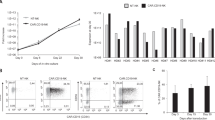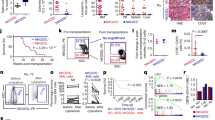Abstract
Irradiation-resistant natural killer (NK) cells in an F1 recipient can reject parental bone marrow, and host NK cells can also prevent engraftment of allogeneic bone marrow. We show here that repopulating bone marrow cells in certain mouse strains expressed retinoic acid early inducible 1 proteins, which are ligands for the activating NKG2D NK cell receptor. Treatment with a neutralizing antibody to NKG2D prevented rejection of parental BALB/c bone marrow in (C57BL/6 × BALB/c) F1 recipients and allowed engraftment of allogeneic BALB.B bone marrow in C57BL/6 recipients. Additionally, bone marrow from C57BL/6 mice transgenic for retinoic acid early inducible 1ε was rejected by syngeneic mice but was accepted after treatment with antibody to NKG2D. If other stem cells or tissues upregulate expression of NKG2D ligands after transplantation, NKG2D may contribute to graft rejection in immunocompetent hosts.
This is a preview of subscription content, access via your institution
Access options
Subscribe to this journal
Receive 12 print issues and online access
$209.00 per year
only $17.42 per issue
Buy this article
- Purchase on Springer Link
- Instant access to full article PDF
Prices may be subject to local taxes which are calculated during checkout






Similar content being viewed by others
References
Lanier, L.L. NK cell recognition. Annu. Rev. Immunol. 23, 225–274 (2005).
Kiessling, R. et al. Evidence for a similar or common mechanism for natural killer cell activity and resistance to hemopoietic grafts. Eur. J. Immunol. 7, 655–663 (1977).
Lotzova, E., Savary, C.A. & Pollack, S.B. Prevention of rejection of allogeneic bone marrow transplants by NK 1.1 antiserum. Transplantation 35, 490–494 (1983).
Murphy, W.J., Kumar, V. & Bennett, M. Rejection of bone marrow allografts by mice with severe combined immune deficiency (scid). Evidence that natural killer cells can mediate the specificity of marrow graft rejection. J. Exp. Med. 165, 1212–1217 (1987).
Murphy, W.J., Kumar, V. & Bennett, M. Natural killer cells activated with interleukin 2 in vitro can be adoptively transferred and mediate hematopoietic histocompatibility-1 antigen-specific bone marrow rejection in vivo. Eur. J. Immunol. 20, 1729–1734 (1990).
Cudkowicz, G. & Stimpfling, J.H. Induction of immunity and of unresponsiveness to parental marrow grafts in adult F-1 hybrid mice. Nature 204, 450–453 (1964).
Cudkowicz, G. & Bennett, M. Peculiar immunobiology of bone marrow allografts. II. Rejection of parental grafts by resistant F 1 hybrid mice. J. Exp. Med. 134, 1513–1528 (1971).
Rembecki, R.M., Kumar, V., David, C.S. & Bennett, M. Bone marrow cell transplants involving intra-H-2 recombinant inbred mouse strains. Evidence that hemopoietic histocompatibility-1 (Hh-1) genes are distinct from H-2D or H-2L. J. Immunol. 141, 2253–2260 (1988).
Sentman, C.L., Hackett, J., Kumar, V. & Bennett, M. Identification of a subset of murine natural killer cells that mediates rejection of Hh-1d but not Hh-1b bone marrow grafts. J. Exp. Med. 170, 191–202 (1989).
Sentman, C.L., Kumar, V. & Bennett, M. Rejection of bone marrow cell allografts by natural killer cell subsets: 5E6+ cell specificity for Hh-1 determinant 2 shared by H-2d and H-2f. Eur. J. Immunol. 21, 2821–2828 (1991).
Yu, Y.Y.L. et al. The role of Ly49A and 5E6 (Ly49C) molecules in hybrid resistance mediated by murine natural killer cells against normal T cell blasts. Immunity 4, 67–76 (1996).
Raziuddin, A., Longo, D.L., Mason, L., Ortaldo, J.R. & Murphy, W.J. Ly-49G2+ NK cells are responsible for mediating the rejection of H-2b bone marrow allografts in mice. Int. Immunol. 8, 1833–1839 (1996).
Raulet, D.H. Roles of the NKG2D immunoreceptor and its ligands. Nat. Rev. Immunol. 3, 781–790 (2003).
Diefenbach, A. et al. Selective associations with signaling proteins determine stimulatory versus costimulatory activity of NKG2D. Nat. Immunol. 3, 1142–1149 (2002).
Radaev, S. & Sun, P.D. Structure and function of natural killer cell surface receptors. Annu. Rev. Biophys. Biomol. Struct. 32, 93–114 (2003).
Cerwenka, A. et al. Retinoic acid early inducible genes define a ligand family for the activating NKG2D receptor in mice. Immunity 12, 721–727 (2000).
Diefenbach, A., Jamieson, A.M., Liu, S.D., Shastri, N. & Raulet, D.H. Ligands for the murine NKG2D receptor: expression by tumor cells and activation of NK cells and macrophages. Nat. Immunol. 1, 119–126 (2000).
Carayannopoulos, L.N., Naidenko, O.V., Fremont, D.H. & Yokoyama, W.M. Murine UL16-binding protein-like transcript 1: a newly described transcript encoding a high-affinity ligand for murine NKG2D. J. Immunol. 169, 4079–4083 (2002).
Nomura, M. et al. Genomic structures and characterization of Rae1 family members encoding GPI-anchored cell surface proteins and expressed predominantly in embryonic mouse brain. J. Biochem. 120, 987–995 (1996).
Zou, Z., Nomura, M., Takihara, Y., Yasunaga, T. & Shimada, K. Isolation and characterization of retinoic acid-inducible cDNA clones in F9 cells: a novel cDNA family encodes cell surface proteins sharing partial homology with MHC class I molecules. J. Biochem. 119, 319–328 (1996).
Cerwenka, A. & Lanier, L.L. NKG2D ligands: unconventional MHC class I-like molecules exploited by viruses and cancer. Tissue Antigens 61, 335–343 (2003).
Malarkannan, S. et al. The molecular and functional characterization of a dominant minor H antigen, H60. J. Immunol. 161, 3501–3509 (1998).
Ogasawara, K. et al. NKG2D blockade prevents autoimmune diabetes in NOD mice. Immunity 20, 757–767 (2004).
Ogasawara, K. et al. Impairment of NK cell function by NKG2D modulation in NOD mice. Immunity 18, 41–51 (2003).
George, T.C., Ortaldo, J.R., Lemieux, S., Kumar, V. & Bennett, M. Tolerance and alloreactivity of the Ly49D subset of murine NK cells. J. Immunol. 163, 1859–1867 (1999).
Lin, J. et al. Ly49I NK cell receptor transgene inhibition of rejection of H2b mouse bone marrow transplants. J. Immunol. 164, 1793–1799 (2000).
Raziuddin, A. et al. Differential effects of the rejection of bone marrow allografts by the depletion of activating versus inhibiting Ly-49 natural killer cell subsets. J. Immunol. 160, 87–94 (1998).
Bix, M. et al. Rejection of class I MHC-deficient haemopoietic cells by irradiated MHC-matched mice. Nature 349, 329–331 (1991).
Nakamura, M.C. et al. Mouse Ly-49D recognizes H-2Dd and activates natural killer cell cytotoxicity. J. Exp. Med. 189, 493–500 (1999).
George, T.C., Mason, L.H., Ortaldo, J.R., Kumar, V. & Bennett, M. Positive recognition of MHC class I molecules by the Ly49D receptor of murine NK cells. J. Immunol. 162, 2035–2043 (1999).
Drizlikh, G., Schmidt-Sole, J. & Yankelevich, B. Involvement of the K and I regions of the H-2 complex in resistance to hemopoietic allografts. J. Exp. Med. 159, 1070–1082 (1984).
Aguila, H.L. & Weissman, I.L. Hematopoietic stem cells are not direct cytotoxic targets of natural killer cells. Blood 87, 1225–1231 (1996).
Ehrlich, L.I.R. et al. Engagement of NKG2D by cognate ligand or antibody alone is insufficient to mediate costimulation of human and mouse CD8+ T cells. J. Immunol. 174, 1922–1931 (2005).
Bakker, A.B.H. et al. DAP12-deficient mice fail to develop autoimmunity due to impaired antigen priming. Immunity 13, 345–353 (2000).
Lodoen, M. et al. NKG2D-mediated natural killer cell protection against cytomegalovirus is impaired by viral gp40 modulation of retinoic acid early inducible 1 gene molecules. J. Exp. Med. 197, 1245–1253 (2003).
Lodoen, M. et al. The cytomegalovirus m155 gene product subverts NK cell antiviral protection by disruption of H60–NKG2D interactions. J. Exp. Med. 200, 1075–1081 (2004).
Murphy, W.J., Kumar, V. & Bennett, M. Acute rejection of murine bone marrow allografts by natural killer cells and T cells: Differences in kinetics and target antigens recognized. J. Exp. Med. 166, 1499–1509 (1987).
Ogasawara, K. et al. Requirement for IRF-1 in the microenvironment supporting development of natural killer cells. Nature 391, 700–703 (1998).
Ogasawara, K., Yoshinaga, S.K. & Lanier, L.L. Inducible costimulator costimulates cytotoxic activity and IFN-γ production in activated murine NK cells. J. Immunol. 169, 3676–3685 (2002).
Lanier, L.L., Ruitenberg, J.J. & Phillips, J.H. Functional and biochemical analysis of CD16 antigen on natural killer cells and granulocytes. J. Immunol. 141, 3478–3485 (1988).
Acknowledgements
We thank N. Killeen and J. Dietrich of the University of California, San Francisco Comprehensive Cancer Center Transgenic and Targeted Mutagenesis Shared Resource for the generation of Rae-1ε-transgenic mice; all Lanier lab members for technical assistance and discussions; and T. Sasazuki for discussions. Supported by the National Institutes of Health (CA95137), the Human Frontier Science Program (K.O.), the Uehara Memorial Foundation (K.O.), the Irvington Institute Foundation (K.O.), the University of California, San Francisco Liver Center (P30-DK26743 to K.O.) and the American Cancer Society (L.L.L.).
Author information
Authors and Affiliations
Corresponding author
Ethics declarations
Competing interests
These studies were supported in part by Schering Plough BioPharma.
Supplementary information
Supplementary Fig. 1
NKG2D mAb CX5 does not deplete NK cells in vivo. (PDF 417 kb)
Supplementary Fig. 2
H-2 incompatibility is not required for NKG2D-dependent BM rejection. (PDF 49 kb)
Rights and permissions
About this article
Cite this article
Ogasawara, K., Benjamin, J., Takaki, R. et al. Function of NKG2D in natural killer cell–mediated rejection of mouse bone marrow grafts. Nat Immunol 6, 938–945 (2005). https://doi.org/10.1038/ni1236
Received:
Accepted:
Published:
Issue Date:
DOI: https://doi.org/10.1038/ni1236
This article is cited by
-
Donor NKG2D rs1049174 polymorphism predicts hematopoietic recovery and event-free survival after single-unit cord blood transplantation in adults
Bone Marrow Transplantation (2024)
-
Modified dendritic cell-derived exosomes activate both NK cells and T cells through the NKG2D/NKG2D-L pathway to kill CML cells with or without T315I mutation
Experimental Hematology & Oncology (2022)
-
Mechanisms of the Effect of Simulated Microgravity on the Cytotoxicity of NK Cells Following the DNA Methylation of NKG2D and the Expression of DAP10
Microgravity Science and Technology (2021)
-
Clonal expansion of innate and adaptive lymphocytes
Nature Reviews Immunology (2020)
-
NK cell recognition of hematopoietic cells by SLAM-SAP families
Cellular & Molecular Immunology (2019)



